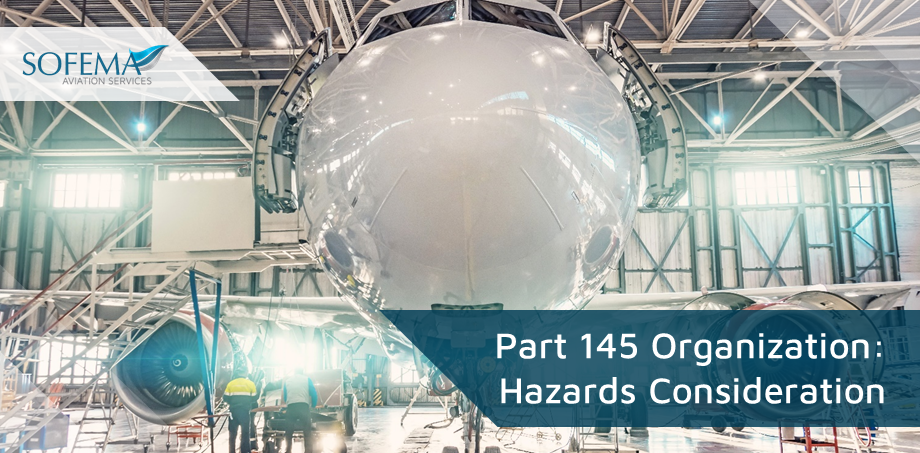Sofema Aviation Services (SAS) www.sassofia.com – Hazards which may be considered within the context of analyzing hazards and developing mitigations within your EASA Part 145 Safety Management System
Implementing a comprehensive safety management system (SMS) in an EASA Part 145 organization, which deals with aircraft maintenance, requires considering a wide range of safety hazards.
The following list covers a broad range of potential hazards in an aviation maintenance environment.
Each of the hazards should be considered for relevance in your organisation, assessed, and mitigated as part of an effective safety management system.
- Aircraft Maintenance Hazards
- Incorrect installation or repair of aircraft components.
- Use of non-certified or substandard parts.
- Inadequate testing of repairs.
- Incomplete maintenance procedures.
- Failure to comply with manufacturer’s specifications.
- Tool and Equipment Hazards
- Faulty or improperly calibrated tools.
- Use of inappropriate tools for the task.
- Poor maintenance of equipment.
- Unavailability of specialized tools.
- Environmental Hazards
- Working in extreme weather conditions (heat, cold, rain, etc.).
- Exposure to hazardous materials (chemicals, fuels, etc.).
- Noise hazards in the hangar or airfield.
- Risk of slips, trips, and falls due to oil, grease, or other fluids.
- Human Factors and Ergonomics
- Fatigue due to long or irregular working hours.
- Physical strain from repetitive tasks or poor ergonomics.
- Stress and mental strain impacting decision-making.
- Communication barriers leading to misunderstandings.
- Electrical Hazards
- Risk of electric shock during maintenance.
- Improper handling of aircraft electrical systems.
- Inadequate grounding and bonding procedures.
- Fire and Explosion Risks
- Mishandling of flammable liquids and gases.
- Unsafe storage of combustibles.
- Sparks in areas with explosive atmosphere.
- Workplace Layout and Design Hazards
- Poorly designed maintenance hangars or workshops.
- Inadequate space for safe maintenance activities.
- Insufficient lighting in work areas.
- Inadequate ventilation.
- Operational Hazards
- Aircraft movement in and around hangars.
- Working at height on aircraft or equipment.
- Uncontrolled access to maintenance areas.
- Collision risks with ground support equipment.
- Health and Safety Policy Lapses
- Lack of safety training and awareness.
- Non-compliance with personal protective equipment (PPE) requirements.
- Inadequate emergency procedures and drills.
- Poor safety culture and management commitment.
- Documentation and Records
- Inaccurate or incomplete maintenance records.
- Failure to track changes in regulations or standards.
- Mismanagement of technical manuals and documentation.
- Quality Control Issues
- Inadequate inspection procedures.
- Failure to detect defects or non-conformities.
- Pressure to complete tasks quickly compromising quality.
- Regulatory and Compliance Risks
- Non-compliance with EASA regulations.
- Lack of understanding of Part 145 requirements.
- Inadequate audits and assessments of compliance.
- Supply Chain and Logistics
- Delays in receiving parts affecting maintenance schedules.
- Dependence on third-party suppliers for critical components.
- Issues with parts traceability and authenticity.
- Emergency Response Preparedness
- Inadequate fire-fighting and first aid resources.
- Poorly planned emergency evacuation routes.
- Lack of training in emergency response.
- Technological Changes and Updates
- Keeping up with advancements in aircraft technology.
- Training staff on new systems and technologies.
- Integrating new tools and software into maintenance processes.
- Management & Oversight
- Lack of or incomplete description of roles, accountabilities and responsibilities
- Limited or lack of resource availability or planning, including staffing
- Lack of or ineffective policies
- Incorrect or incomplete procedures including instructions
- Lack of or Poor Management, Culture and or Manpower relationships
- Lack of or Ineffective Organizational Structure
- Poor organizational safety culture
- Lack of or ineffective safety management processes (including risk management, safety assurance, auditing, training and resource allocation)
- Lack or ineffective audit procedures
- Training and Competence Hazards
- Insufficient training for maintenance personnel on specific aircraft models or systems.
- Lack of ongoing professional development and refresher training programs.
- Inadequate competency assessment procedures to ensure skills and knowledge are up-to-date.
- Failure to train staff on new regulatory changes or industry best practices.
- Inadequate training on the use of new tools or technologies introduced into the maintenance process.
- Poor knowledge management practices, leading to loss of critical skills and experience.
- Reliance on informal, on-the-job training without formal certification or assessment.
- Certification and Licensing Risks
- Related to Certification
- Maintenance personnel working without proper licenses or certifications.
- Expired certifications or licenses not being renewed in a timely manner.
- Inadequate verification of external training or certifications from new hires.
- Failure to maintain records of employee certifications and training histories.
Safety Culture and Awareness Training
- Lack of safety culture awareness programs within the organization.
- Ineffective communication of safety principles and practices to all staff levels.
- Failure to integrate safety culture training into the onboarding process for new hires.
- Inadequate training on hazard identification, risk assessment, and mitigation techniques.
Supervision and Mentorship Deficiencies
- Insufficient supervision of junior or less experienced maintenance staff.
- Lack of mentorship programs to facilitate knowledge transfer and skill development.
- Over-reliance on experienced staff without adequately training juniors for future roles.
- Inadequate performance monitoring and feedback mechanisms to identify training needs.
- Emergency and Special Situation Training
Inadequate training on handling emergency situations specific to aviation maintenance.
- Failure to conduct regular drills or simulations for emergency scenarios.
- Lack of specialized training for handling hazardous materials or extreme weather conditions.
- Inadequate training on the use and maintenance of personal protective equipment (PPE).
Next Steps
Follow this link to our Library to find & download related documents for Free.
For multiple safety management system training courses including risk assessment and implementation please see www.sassofia.com and www.sofemaonline.com or email team@sassofia.com
Tags:
Aircraft Maintenance, Compliance Risks, Design Hazards, EASA Part 145 Safety Management System, Environmental Hazards, Equipment Hazards, Ergonomics, Explosion Risks, Hazard Consideration, Human Factors, Safety Culture, Safety Policy Lapses, SAS blogs




